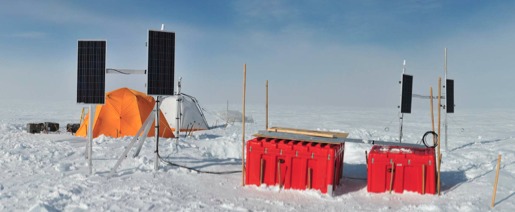IRIS PASSCAL Instrument Center Presentations at the Seismological Society of America 2014 Meeting
 Several staff members of the IRIS PASSCAL Instrument Center are making presentations at this year's Seismological Society of America Annual Meeting in Anchorage, Alaska.
Several staff members of the IRIS PASSCAL Instrument Center are making presentations at this year's Seismological Society of America Annual Meeting in Anchorage, Alaska.
Here follow abstracts for our three presentations, along with links to the posters.
Running realtime, year-round seismic stations across the Greenland Ice Sheet
Dean Childs, Mouse Marie Reusch, and Bruce Beaudoin
Advances in the design and build of very low-power and cold-tolerant seismic and communication instruments have led to a larger presence of seismic stations in the polar regions. Presented here is an update of the technology and methodology that allows the year-round-operation of PASSCAL-monitored stations in the GLISN project. Station designs pioneered at PASSCAL in the Polar program have improved the durability and endurance of polar seismic stations. Enclosed systems have been developed to allow for batteries and key electronics to stay inside a vacuum-panel-insulated station enclosure with bulkhead connectors to external cabling, reducing the station installation complexity and isolating the internal instrumentation from the harsh external environment. To address the equipment and battery low-end operating temp limitations (~-40C) and the limited and costly deep-field transportation resources, the station overall design requires a careful balance between: low power consumption, battery array size, insulation, and power-production capability. In the past, most seismic telemetry from cold/remote sites has only transmitted limited state of health (SOH) and allowed limited remote command/control of the instruments. Data are recovered by on-site visits every 1-2years. A new type of Iridium telemetry using existing Xeos modems (RUDICS) was introduced in 2012, and established at 6 seismic stations. This allowed for the 3X/day automated collection of all continuous SOH and 1Hz seismic data. Station-side problems can be deciphered with greater clarity and confidence and sometimes solved remotely and, if this is not possible, allow for a better-prepared field visit. In 2013, after extensive in-house and field-prototype testing, 2 stations were upgraded to pull both 20 and 1Hz data streams in real-time using full time RUDICS. Future plans are to expand the RUDICS real-time to the remaining stations and to begin testing at other high-latitude stations managed by PASSCAL.
Wednesday, April 30th, Poster #22, Cook/Arteaga
What have we learned from data from purpose-built, direct-bury sensors at Poker Flat, Alaska?
K.E. Anderson, G. Slad, M.M. Reusch, W. Hutton, P. Miller, C. Pfeifer, N. Barstow, T. Parker, B. Beaudoin, J. Gridley
Optimizing speed and efficiency for deploying temporary seismic stations can greatly reduce logistics costs in remote areas. The IRIS/PASSCAL Instrument Center (PIC) has been exploring methods for emplacing broadband sensors that reduce the time and materials required. Questions remain as to whether these new emplacement techniques produce data of equivalent or better quality than standard temporary seismic vaults. To test the impact of sensor emplacement on data quality, the PIC completed co-located installations in July 2013 at Poker Flat, Alaska, allowing the comparison of data quality and sensor performance from purpose-built direct-bury broadband sensors emplaced in augered holes with observatory-type broadband sensors installed in Transportable Array (TA) and PASSCAL-style temporary vaults. To date, analysis has shown these directly-buried sensors provide similar quality data to that of sensors installed in temporary vaults, while offering the benefits of reduced deployment time, construction material, and logistical requirements. Meeting these criteria is critical to allow Principle Investigators to effectively and efficiently deploy within the future TA Alaska footprint. Median PSD calculations from the Poker Flat installations, through November 2013, show that the direct-bury installations compare favorably with PASSCAL-style temporary vault installations. Direct-bury installation median PSDs are also comparable to those of the nearby TA vault installation: the horizontal components to periods as long as 10 seconds and the vertical components to beyond 100 seconds. With the additional data collected through Spring 2014, we analyze the performance of direct-bury installations vs. temporary-vault installations using monthly and seasonal PSD PDFs, magnitude-squared coherence, signal-to-noise ratios, and cross-correlation.
Wednesday, April 30th, Poster #35, Cook/Arteaga
Polar Seismology: Engineered Solutions from the IRIS/PASSCAL Instrument Center
T. Parker, P. Carpenter, B. Beaudoin
The IRIS/PASSCAL Instrument Center at New Mexico Tech established a directed effort to address the complexities of deploying seismic equipment in Polar environments in 2006. A joint NSF MRI with UNAVCO to develop power and communications solutions for Antarctic deployments initially funded the effort. This development focused on: dual primary/secondary battery power systems, enclosures to maintain temperatures within the equipment’s operating specifications, Iridium communications for state-of-health, minimizing logistics, and working with manufacturers to encourage the development of purpose-built equipment for Polar environments. These early efforts realized increases in data return for year around deployments from roughly 50% to over 90%. With continued NSF support, IRIS/PASSCAL has been able to continue to refine and modify these early designs and enhance PI success. Coupled with this continued development is a new generation of equipment that is more suited to the Polar environment. Our presentation will highlight both IRIS/PASSCAL’s current engineered solutions for Polar environments and explore future directions in light of emerging technologies.
Wednesday, April 30th, 9:00 AM Oral, Room 7/8
- Home
- General Information
- Instrumentation
- Dataloggers
- Sensors
- All-In-One Systems
- Power Systems
- Field Procedures
- Controlled Sources
- Seismic Source Facility
- Magnetotelluric Systems at PASSCAL
- Ground Penetrating Radar
- Power and Memory Calculations Form
- Data Archiving
- Apply for a PI Account
- Experiment Scheduling
- Polar
- Important Hardware/Software Notes
- USArray
- Software
Also See
- Seismological Society of America 2009 Annual Meeting Presentations
- P.I. Transition coming to the IRIS/PASSCAL Instrument Center
- IRIS/PASSCAL Instrument Center User Workshop, AGU San Francisco - 2010
- PASSCAL Posters at 2014 IRIS Workshop, June 8-11, in Sunriver, Oregon
- New Mexico Tech to Expand PASSCAL Instrument Center

